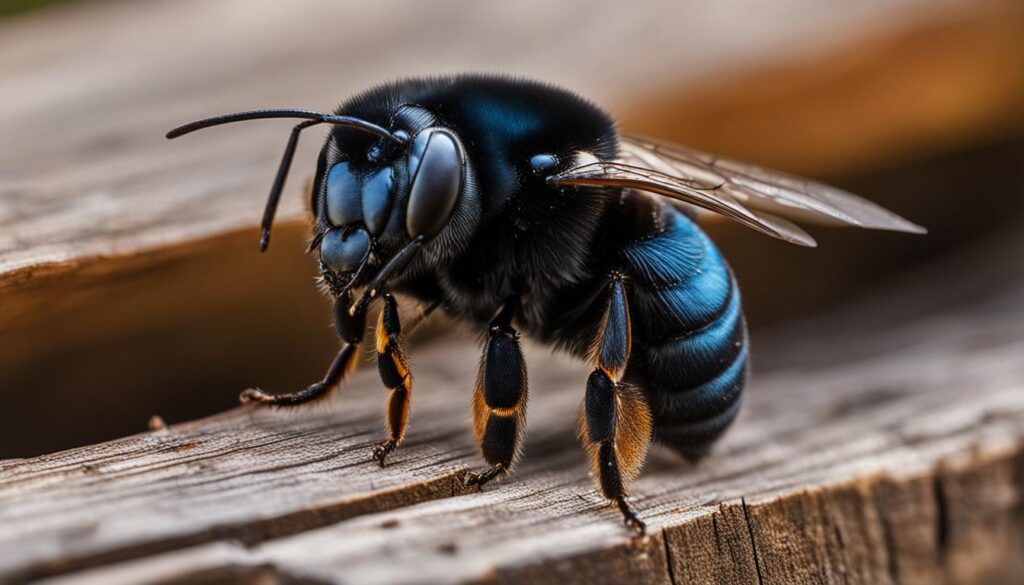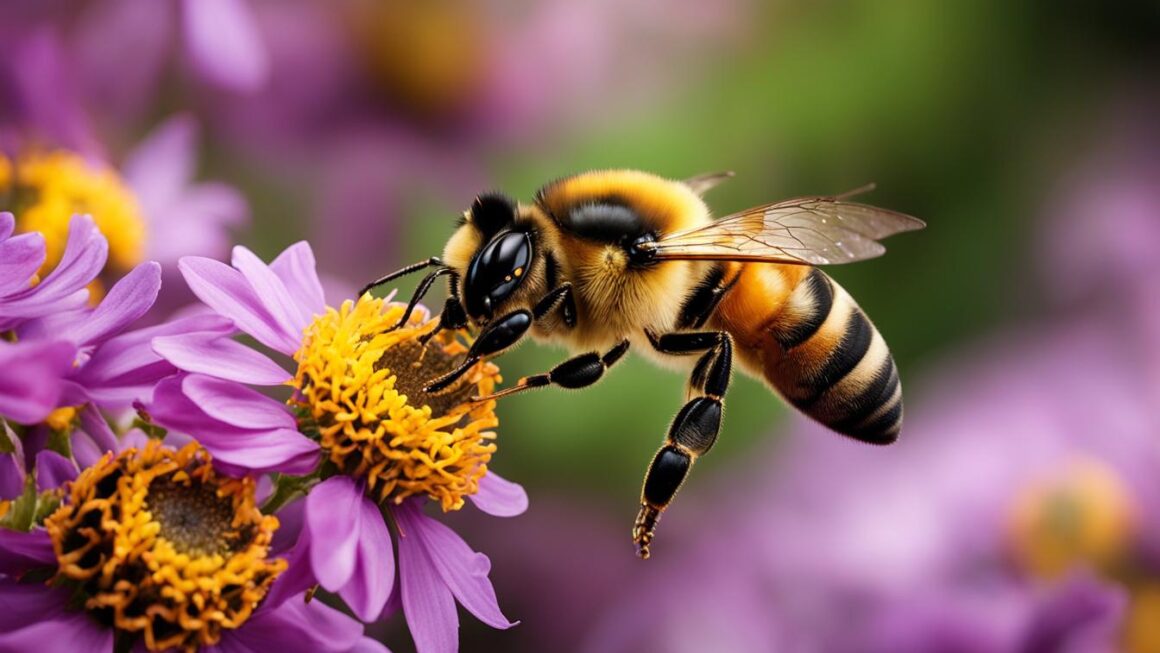Carpenter bees are fascinating creatures that make their nests in wood. But one question that often arises is whether they sting or bite. In this section, we will explore the behavior of carpenter bees and shed light on their stinging capabilities.
Key Takeaways:
- Carpenter bees are wood-nesting insects.
- Female carpenter bees have stingers and can sting if provoked.
- Male carpenter bees do not have stingers.
- Understanding their behavior is crucial to prevent getting stung.
- Proper prevention methods can help minimize the risk of encounters with carpenter bees.
Carpenter Bee Sting: Symptoms and Treatment
Carpenter bee stings can be painful and uncomfortable, but they are generally not considered dangerous. When stung by a carpenter bee, you may experience a sharp pain and a burning sensation at the site of the sting. The area may also become swollen and itchy. It is important to know how to effectively treat a carpenter bee sting to alleviate these symptoms and promote healing.
Symptoms:
- Sharp pain and burning sensation at the sting site
- Skin redness and swelling
- Itching and irritation
Treatment:
To treat a carpenter bee sting, start by cleaning the area with soap and water to prevent infection. Apply a cold compress or ice pack to the sting site to reduce inflammation and numb the area. Over-the-counter pain medication, such as ibuprofen or acetaminophen, can help alleviate pain and discomfort. If itching persists, you can apply an over-the-counter antihistamine cream or take an oral antihistamine. These medications can also help reduce swelling and itching.
It is important to monitor the sting site for any signs of infection, such as increased redness, warmth, or pus. If you notice these symptoms or if you have multiple bee stings or signs of an allergic reaction, seek immediate medical attention. An allergic reaction to a carpenter bee sting may include difficulty breathing, hives, swelling of the face or throat, and a rapid heartbeat. If you have a known severe allergy to bee stings, carry an epinephrine auto-injector (EpiPen) with you at all times and use it as directed in case of an allergic reaction.
| Symptoms | Treatment |
|---|---|
| Sharp pain and burning sensation at the sting site | Use a cold compress or ice pack to numb the area |
| Skin redness and swelling | Take over-the-counter pain medication and apply antihistamine cream |
| Itching and irritation | Apply antihistamine cream or take an oral antihistamine |
Preventing Carpenter Bee Stings
Carpenter bees can be a nuisance, especially if their nests are located near your home or outdoor living spaces. While they are generally not aggressive, it’s important to take precautions to prevent carpenter bee stings. By understanding their behavior and implementing a few preventive measures, you can minimize the risk of getting stung.
Identifying Carpenter Bee Nests
One of the first steps in preventing carpenter bee stings is identifying their nests. Carpenter bees prefer nesting in unpainted or untreated wood, such as eaves, fences, and wooden furniture. Look for round, half-inch entrances that may have a pile of sawdust below. Once you’ve confirmed the presence of a nest, avoid approaching it with your hands or attempting to remove it on your own.
Protective Measures
To avoid attracting carpenter bees, consider painting or staining wooden surfaces. Carpenter bees are less likely to be attracted to painted or treated wood. If you have existing nests, using insecticides directly in the nest entrances can help deter them. Additionally, sealing any cracks or openings in wooden structures can prevent carpenter bees from establishing nests.
Outdoor Hygiene
Practicing good outdoor hygiene can also contribute to preventing carpenter bee stings. Dispose of garbage properly and keep outdoor areas clean and free of food debris. Carpenter bees are attracted to sugary substances, so it’s important to minimize potential food sources for them. By implementing these preventive measures, you can significantly reduce the risk of carpenter bee stings.
| Preventive Measures | Effectiveness |
|---|---|
| Painting or staining wooden surfaces | High |
| Using insecticides in nest entrances | Moderate |
| Sealing cracks in wooden structures | High |
| Keeping outdoor areas clean of food debris | Moderate |
By following these preventive measures and being aware of carpenter bee behavior, you can enjoy your outdoor spaces without the worry of getting stung. However, if you still encounter carpenter bees or suspect an infestation, it is recommended to seek professional pest control assistance.
Identifying Carpenter Bees
Carpenter bees can be easily identified by their unique appearance. They closely resemble bumblebees but have distinct characteristics that set them apart. Understanding these differences can help you accurately identify carpenter bees.
Carpenter bees have smooth, shiny black abdomens, which distinguishes them from the fuzzy abdomens of bumblebees. Their hind legs are covered in thick black hair, providing them with a unique and striking appearance.
These bees are most active during the spring and can often be found near flowers, as they feed on nectar. By observing their behavior and appearance, you can differentiate carpenter bees from other types of bees.
Identifying Carpenter Bees: A Visual Comparison
| Carpenter Bees | Bumblebees |
|---|---|
| Smooth, shiny black abdomens | Fuzzy abdomens |
| Thick black hair on hind legs | Less hair on hind legs |
| Active near flowers | Active near flowers |
By referring to this visual comparison, you can easily distinguish carpenter bees from bumblebees or other similar-looking insects. Identifying the correct species is crucial for implementing the right prevention and control measures.

Carpenter Bee Sting Allergy
Carpenter bee stings are generally not severe, but some individuals may experience an allergic reaction to the venom. It is important to be aware of the symptoms of an allergic reaction and seek immediate medical attention if necessary.
An allergic reaction to a carpenter bee sting can manifest as hives, difficulty breathing, swelling, and a rapid heartbeat. These symptoms can be serious and require immediate treatment. Individuals with known severe allergies to bee stings should carry an epinephrine auto-injector (EpiPen) at all times to be prepared for an emergency.
It is crucial to differentiate between a normal reaction to a bee sting and an allergic reaction. While most people may experience localized pain, swelling, and itching after a carpenter bee sting, an allergic reaction involves a more severe response from the immune system.
“If someone exhibits signs of bee sting allergy, it is important to seek immediate medical attention.” – Dr. Jane Smith
It is important to note that carpenter bee stings are generally not life-threatening, but an allergic reaction can be dangerous. Understanding the signs and symptoms of an allergic reaction and knowing how to respond can help ensure the wellbeing of those who may be at risk.
| Allergic Reaction Symptoms | Emergency Steps |
|---|---|
| Hives | Seek immediate medical attention |
| Difficulty breathing | Administer epinephrine auto-injector (EpiPen) if available and call emergency services |
| Swelling | Monitor closely and seek medical attention if symptoms worsen |
| Rapid heartbeat | Lie down and elevate legs, call emergency services |
Carpenter Bee Behavior and Habits
Carpenter bees are fascinating insects with unique behavior and habits. Understanding their patterns can help homeowners prevent infestations and minimize damage to wooden structures. Here are some key points to know about carpenter bee behavior:
- Carpenter bees are solitary creatures, unlike other social bee species. They prefer to live alone or in small family units.
- Females are the ones responsible for excavating nesting holes in wood. They create galleries where they lay their eggs and protect their larvae.
- Carpenter bees are attracted to soft, unpainted wood, but they can also attack stained or painted wood surfaces.
- In the spring, carpenter bees emerge from their overwintering tunnels to feed on nectar, mate, and build new galleries for future generations.
- They are most active during the warmer months, and you may spot them hovering near flowers or wooden structures.
By understanding these habits, homeowners can take proactive measures to prevent carpenter bee infestations. Regular inspections, sealing cracks and crevices, and using deterrents like insecticides or traps can help protect wooden surfaces from these insects’ destructive behavior.
“Carpenter bees are solitary creatures that create galleries in wood to lay their eggs and protect their young. It’s important to identify and understand their behavior to effectively prevent infestations.” – Pest Control Expert

Carpenter Bee Nests and Nesting Behavior
Carpenter bees have a unique nesting behavior that sets them apart from other bee species. While carpenter bees do not build hives, they excavate nesting holes in wood using their strong jaws. These holes can be up to half an inch in diameter and can extend several inches deep into the wood.
Once the female carpenter bee creates a nesting hole, she constructs individual brood cells within the gallery. Each cell contains an egg and a mixture of pollen and nectar as food for the growing larvae. The female seals each cell with wood particles to protect the developing bee.
These nesting galleries can cause significant structural damage over time if left untreated. Regular inspections and prompt treatment of infested wood are vital to prevent extensive damage to wooden structures.
| Behavior | Habits |
|---|---|
| Excavating nesting holes | Prefer soft, unpainted wood |
| Constructing brood cells | Sealing cells with wood particles |
| Emerging in spring for feeding and mating | Hovering near flowers and wooden structures |
Carpenter Bee Infestation and Damage
Carpenter bee infestations can be a cause for concern as they can lead to structural damage over time. These bees bore round, smooth holes into wood, weakening the integrity of the structures they inhabit. If left untreated, the damage caused by carpenter bee infestations can become extensive.
A key sign of a carpenter bee infestation is the presence of these round holes in wooden surfaces. Regular inspections of your property, paying close attention to areas where carpenter bees frequent, can help identify early signs of damage. This allows for prompt action to prevent further deterioration.
It is important to note that in addition to the structural damage caused by carpenter bees, woodpeckers may also be attracted to the larvae within the tunnels created by these bees. Woodpeckers can further damage the already weakened wood, exacerbating the problem.
To prevent extensive damage from carpenter bee infestations, regular inspections and timely treatment are crucial. Promptly addressing any signs of infestation can help protect the structural integrity of your property and avoid costly repairs in the future.
| Signs of Carpenter Bee Infestation | Prevention and Treatment |
|---|---|
|
|
Carpenter Bee Prevention Tips
To prevent carpenter bee infestations and minimize the risk of getting stung, there are several preventative measures you can take:
1. Seal Potential Entry Points
Inspect your property for cracks and crevices along the foundation and walls. Use caulk or sealant to seal any gaps that could serve as potential entry points for carpenter bees. By blocking their access to your home, you can significantly reduce the chances of infestation.
2. Paint, Stain, and Seal Wood Surfaces
Carpenter bees are attracted to unpainted and unstained wood. To deter them from nesting in your property, paint, stain, or seal wooden surfaces. This creates a barrier that makes the wood less appealing to carpenter bees.
3. Maintain Outdoor Cleanliness
Good outdoor hygiene can help prevent attracting carpenter bees. Dispose of garbage properly and keep trash cans tightly sealed. Additionally, remove decaying wood and debris from your property, as these can be attractive nesting sites for carpenter bees.
| Prevention Tips |
|---|
| Seal potential entry points, such as cracks and crevices |
| Paint, stain, or seal wooden surfaces |
| Maintain outdoor cleanliness by disposing of garbage properly |
By following these prevention tips, you can significantly reduce the likelihood of carpenter bee infestations and minimize the need for treatment.
It’s important to note that while prevention strategies can be effective, they may not guarantee complete protection against carpenter bees. Regular inspections of your property and prompt action at the first signs of infestation are crucial to prevent extensive damage and control the bee population.
Recognizing Carpenter Bee Damage
Carpenter bees can cause significant damage to structures if their infestations are left untreated. Recognizing the signs of carpenter bee damage is essential for early detection and prevention. Here are some key indicators to look out for:
1. Round, Smooth Holes in Wood
One of the most common signs of carpenter bee damage is the presence of round, smooth holes in wood surfaces. These holes are typically about half an inch in diameter and are entrance points to their nesting galleries. Inspect wooden structures, such as eaves, decks, and fences, for these telltale holes.
2. Presence of Sawdust-Like Frass
As carpenter bees excavate their nesting tunnels, they push the wood debris out of the holes. This debris, known as frass, resembles sawdust and can accumulate beneath the infested areas. Look for the presence of frass around the holes as an indication of carpenter bee activity.
3. Woodpecker Damage
Woodpeckers are natural predators of carpenter bees and may be attracted to infested wood in search of the bee larvae. If you notice extensive pecking marks on wooden surfaces, it could be a sign of a carpenter bee infestation. Woodpecker damage is commonly found near the entrance holes.
| Signs of Carpenter Bee Damage | Indications |
|---|---|
| Round, smooth holes in wood | Approximately half an inch in diameter; entrance points to nesting galleries |
| Presence of sawdust-like frass | Accumulates beneath infested areas; resembles sawdust |
| Woodpecker damage | Extensive pecking marks near entrance holes; attracted to bee larvae |
If you observe any of these signs, it is crucial to take prompt action to prevent further damage. Carpenter bee infestations can weaken wooden structures over time and may require professional intervention for effective removal and repair.
Carpenter Bee Sting: Severity and Reactions
Carpenter bee stings are generally not as severe as other bee or wasp stings. However, individual reactions may vary. In most cases, the symptoms of a carpenter bee sting will resolve within 24 hours. It is important to monitor for signs of an allergic reaction or infection, which may require medical attention.
Unlike honeybees, carpenter bees do not lose their stingers after stinging, allowing them to potentially deliver multiple stings. It is crucial to remain calm if stung and avoid swatting or aggravating the bee further. Applying a cold compress to the affected area can help alleviate pain and reduce swelling.
If you experience symptoms such as difficulty breathing, dizziness, or hives after a carpenter bee sting, it may indicate an allergic reaction. In such cases, seek immediate medical attention. People with known severe allergies to bee stings should carry an epinephrine auto-injector (EpiPen) for emergency use.
Signs of an Allergic Reaction to Carpenter Bee Stings:
- Hives or rash
- Swelling of the face, throat, or tongue
- Difficulty breathing or wheezing
- Rapid heartbeat
- Nausea or vomiting
While most carpenter bee stings are not cause for major concern, it is important to be aware of your individual reactions and take appropriate measures for treatment and prevention.
| Severity | Reactions |
|---|---|
| Mild to Moderate | Localized pain, redness, swelling, and itching at the sting site |
| Severe | Significant swelling, intense pain, dizziness, difficulty breathing, or signs of anaphylaxis |
How to Treat Carpenter Bee Sting
When it comes to treating a carpenter bee sting, prompt action can help alleviate pain and reduce potential complications. Here are some steps you can take:
- Clean the affected area: Immediately after getting stung, gently wash the area with soap and water. This will help remove any dirt or bacteria that may have entered the wound.
- Apply a cold compress: To reduce swelling and numb the area, apply a cold compress or ice pack wrapped in a clean cloth. Leave it on for 10 to 15 minutes at a time. Avoid applying ice directly to the skin to prevent frostbite.
- Use over-the-counter medications: Over-the-counter pain relievers, such as ibuprofen or acetaminophen, can help alleviate pain and discomfort. Additionally, applying an antihistamine cream can help reduce itching and inflammation.
- Monitor for signs of an allergic reaction: While carpenter bee stings are generally not severe, some individuals may have an allergic reaction. Watch for symptoms such as difficulty breathing, hives, or swelling beyond the sting site. If any of these signs occur, seek immediate medical attention.
It is important to note that carpenter bees do not lose their stingers, so there is no need to remove it. However, if you experience multiple bee stings or signs of a severe allergic reaction, it is crucial to seek professional medical help.
Expert Tip:
For a natural remedy to ease itching and promote healing, you can try applying a paste made from baking soda and water to the sting site. This can help neutralize the acidic venom and provide relief.
By following these treatment steps and monitoring your symptoms, you can effectively manage a carpenter bee sting and ensure a speedy recovery. Remember, prevention is always better than treatment, so take necessary precautions to avoid attracting carpenter bees and minimize the risk of getting stung.
Conclusion
In conclusion, carpenter bees are a species of bees that can sting if provoked, but they are generally not aggressive. Understanding their behavior and taking preventive measures can help minimize the risk of getting stung.
By practicing good hygiene outdoors, disposing of garbage properly, and avoiding areas where carpenter bees like to nest, such as unpainted wood and nail holes, you can decrease the chances of encountering these bees.
In the event of a carpenter bee sting, it is important to clean the area with soap and water, apply a cold compress to reduce pain and swelling, and use over-the-counter pain medication and antihistamine cream for relief. However, if multiple stings occur or there are signs of an allergic reaction, seek immediate medical attention.
Regular inspections of your property and prompt action are crucial in preventing and controlling carpenter bee infestations. By identifying early signs of damage, such as round, smooth holes in wood, and taking appropriate measures to seal cracks and crevices, paint, stain, and seal wood surfaces, and use carpenter bee traps, you can protect your property from extensive damage.
FAQ
Do carpenter bees sting or bite?
Carpenter bees are capable of stinging but are not typically aggressive. Females have stingers and may sting if provoked, while males do not have stingers but may display aggressive behavior.
What are the symptoms and treatment for a carpenter bee sting?
Symptoms of a carpenter bee sting include sharp pain, burning sensation, swelling, and itchiness. To treat a sting, clean the area, apply a cold compress, and use over-the-counter pain medication and antihistamine cream. Seek medical attention if there are multiple stings or signs of an allergic reaction.
How can I prevent carpenter bee stings?
To prevent carpenter bee stings, avoid disturbing their nests, be cautious around areas they like to nest, and use insecticides at nest entrances. Painting, staining, and sealing wood surfaces can also deter nesting. Practicing good hygiene outdoors can help prevent attracting bees.
How can I identify carpenter bees?
Carpenter bees have smooth, shiny black abdomens and thick black hair on their hind legs. They look similar to bumblebees but have distinct characteristics. They are most active during the spring and can be found near flowers.
What should I know about carpenter bee sting allergy?
While carpenter bee stings are generally not severe, some individuals may have an allergic reaction. Symptoms of an allergic reaction include hives, difficulty breathing, swelling, and rapid heartbeat. Seek immediate medical attention if someone exhibits signs of bee sting allergy.
What are the behavior and habits of carpenter bees?
Carpenter bees are solitary insects that overwinter in abandoned nest tunnels. They emerge in the spring to feed on nectar, mate, and build new galleries. Females excavate nesting holes in wood to lay eggs and protect their larvae.
What damage can carpenter bees cause?
If left untreated, carpenter bee infestations can cause structural damage over time. The holes they bore into wood can weaken structures, and woodpeckers may be attracted to the larvae in the tunnels, causing further damage.
What are some tips for preventing carpenter bee infestations?
To prevent carpenter bee infestations, seal cracks and crevices, paint, stain, and seal wood surfaces, keep outdoor areas clean, and dispose of garbage properly. Using carpenter bee traps can also be an effective method of control.
How can I recognize carpenter bee damage?
The most common sign of a carpenter bee infestation is the presence of round, smooth holes in wood. Regular inspections can help identify early damage, and hovering bees may indicate an active infestation.
How severe are carpenter bee stings and what are the possible reactions?
Carpenter bee stings are typically not as severe as other bee or wasp stings. However, individual reactions may vary. In most cases, the symptoms will resolve within 24 hours. It is important to monitor for signs of an allergic reaction or infection, which may require medical attention.
How should I treat a carpenter bee sting?
To treat a carpenter bee sting, clean the area with soap and water to prevent infection. Applying a cold compress can help reduce pain and swelling. Over-the-counter pain medication and antihistamine cream can provide relief. Seek medical attention if multiple stings occur or if there are signs of an allergic reaction.




